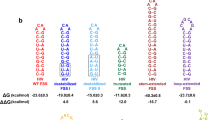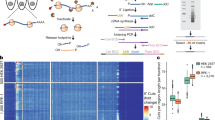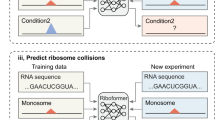Abstract
The journey of a newly synthesized polypeptide starts in the peptidyltransferase center of the ribosome, from where it traverses the exit tunnel. The interior of the ribosome exit tunnel is neither straight nor smooth. How the ribosome dynamics in vivo is influenced by the exit tunnel is poorly understood. Genome-wide ribosome profiling in mammalian cells reveals elevated ribosome density at the start codon and surprisingly the downstream 5th codon position as well. We found that the highly focused ribosomal pausing shortly after initiation is attributed to the geometry of the exit tunnel, as deletion of the loop region from ribosome protein L4 diminishes translational pausing at the 5th codon position. Unexpectedly, the ribosome variant undergoes translational abandonment shortly after initiation, suggesting that there exists an obligatory step between initiation and elongation commitment. We propose that the post-initiation pausing of ribosomes represents an inherent signature of the translation machinery to ensure productive translation.
Similar content being viewed by others
Log in or create a free account to read this content
Gain free access to this article, as well as selected content from this journal and more on nature.com
or
References
Buchan JR, Stansfield I . Halting a cellular production line: responses to ribosomal pausing during translation. Biol Cell 2007; 99:475–487.
Kertesz M, Wan Y, Mazor E, et al. Genome-wide measurement of RNA secondary structure in yeast. Nature 2010; 467:103–107.
Plotkin JB, Kudla G . Synonymous but not the same: the causes and consequences of codon bias. Nat Rev Genet 2011; 12:32–42.
Kramer G, Boehringer D, Ban N, Bukau B . The ribosome as a platform for co-translational processing, folding and targeting of newly synthesized proteins. Nat Struct Mol Biol 2009; 16:589–597.
Farabaugh PJ . Translational frameshifting: implications for the mechanism of translational frame maintenance. Prog Nucleic Acid Res Mol Biol 2000; 64:131–170.
Doma MK, Parker R . Endonucleolytic cleavage of eukaryotic mRNAs with stalls in translation elongation. Nature 2006; 440:561–564.
Komar AA . A pause for thought along the co-translational folding pathway. Trends Biochem Sci 2009; 34:16–24.
Liu B, Han Y, Qian SB . Cotranslational response to proteotoxic stress by elongation pausing of ribosomes. Mol Cell 2013; 49:453–463.
Shalgi R, Hurt JA, Krykbaeva I, Taipale M, Lindquist S, Burge CB . Widespread regulation of translation by elongation pausing in heat shock. Mol Cell 2013; 49:439–452.
Wolin SL, Walter P . Ribosome pausing and stacking during translation of a eukaryotic mRNA. EMBO J 1988; 7:3559–3569.
Ingolia NT, Ghaemmaghami S, Newman JR, Weissman JS . Genome-wide analysis in vivo of translation with nucleotide resolution using ribosome profiling. Science 2009; 324:218–223.
Guo H, Ingolia NT, Weissman JS, Bartel DP . Mammalian microRNAs predominantly act to decrease target mRNA levels. Nature 2010; 466:835–840.
Brar GA, Yassour M, Friedman N, Regev A, Ingolia NT, Weissman JS . High-resolution view of the yeast meiotic program revealed by ribosome profiling. Science 2012; 335:552–557.
Oh E, Becker AH, Sandikci A, et al. Selective ribosome profiling reveals the cotranslational chaperone action of trigger factor in vivo. Cell 2011; 147:1295–1308.
Li GW, Oh E, Weissman JS . The anti-Shine-Dalgarno sequence drives translational pausing and codon choice in bacteria. Nature 2012; 484:538–541.
Bazzini AA, Lee MT, Giraldez AJ . Ribosome profiling shows that miR-430 reduces translation before causing mRNA decay in zebrafish. Science 2012; 336:233–237.
Stadler M, Artiles K, Pak J, Fire A . Contributions of mRNA abundance, ribosome loading, and post- or peri-translational effects to temporal repression of C. elegans heterochronic miRNA targets. Genome Res 2012; 22:2418–2426.
Gerashchenko MV, Lobanov AV, Gladyshev VN . Genome-wide ribosome profiling reveals complex translational regulation in response to oxidative stress. Proc Natl Acad Sci USA 2012; 109:17394–17399.
Lee S, Liu B, Huang SX, Shen B, Qian SB . Global mapping of translation initiation sites in mammalian cells at single-nucleotide resolution. Proc Natl Acad Sci USA 2012; 109:E2424–E2432.
Guydosh NR, Green R . Dom34 rescues ribosomes in 3′ untranslated regions. Cell 2014; 156:950–962.
O'Connor PB, Li GW, Weissman JS, Atkins JF, Baranov PV . rRNA:mRNA pairing alters the length and the symmetry of mRNA-protected fragments in ribosome profiling experiments. Bioinformatics 2013; 29:1488–1491.
Schneider-Poetsch T, Ju J, Eyler DE, et al. Inhibition of eukaryotic translation elongation by cycloheximide and lactimidomycin. Nat Chem Biol 2010; 6:209–217.
Rooijers K, Loayza-Puch F, Nijtmans LG, Agami R . Ribosome profiling reveals features of normal and disease-associated mitochondrial translation. Nat Commun 2013; 4:2886.
Wilson DN, Beckmann R . The ribosomal tunnel as a functional environment for nascent polypeptide folding and translational stalling. Curr Opin Struct Biol 2011; 21:274–282.
Klinge S, Voigts-Hoffmann F, Leibundgut M, Arpagaus S, Ban N . Crystal structure of the eukaryotic 60S ribosomal subunit in complex with initiation factor 6. Science 2011; 334:941–948.
Starosta AL, Karpenko VV, Shishkina AV, et al. Interplay between the ribosomal tunnel, nascent chain, and macrolides influences drug inhibition. Chem Biol 2010; 17:504–514.
Heurgue-Hamard V, Mora L, Guarneros G, Buckingham RH . The growth defect in Escherichia coli deficient in peptidyl-tRNA hydrolase is due to starvation for Lys-tRNA(Lys). EMBO J 1996; 15:2826–2833.
Petrov A, Kornberg G, O'Leary S, Tsai A, Uemura S, Puglisi JD . Dynamics of the translational machinery. Curr Opin Struct Biol 2011; 21:137–145.
Tenson T, Ehrenberg M . Regulatory nascent peptides in the ribosomal tunnel. Cell 2002; 108:591–594.
Zhang Y, Wolfle T, Rospert S . Interaction of nascent chains with the ribosomal tunnel proteins Rpl4, Rpl17, and Rpl39 of Saccharomyces cerevisiae. J Biol Chem 2013; 288:33697–33707.
Langmead B, Trapnell C, Pop M, Salzberg SL . Ultrafast and memory-efficient alignment of short DNA sequences to the human genome. Genome Biol 2009; 10:R25.
Huang da W, Sherman BT, Lempicki RA . Systematic and integrative analysis of large gene lists using DAVID bioinformatics resources. Nat Protoc 2009; 4:44–57.
Acknowledgements
We thank members of the Qian laboratory for critical reading of the manuscript and Dr Jonathan Yewdell (NIAID, NIH) for providing anti-puromycin monoclonal antibody. B L is partly supported by the Genomics Scholar's Award from Center for Vertebrate Genomics at Cornell. This work was supported by grants from National Institutes of Health (1 DP2 OD006449-01), Ellison Medical Foundation (AG-NS-0605-09), and DOD Exploration-Hypothesis Development Award (W81XWH-11-1-0236) to S-B Q.
Author information
Authors and Affiliations
Corresponding author
Additional information
( Supplementary information is linked to the online version of the paper on the Cell Research website.)
Supplementary information
Supplementary information, Figure S1
Reproducibility of post-initiation pausing in HEK293 cells. (PDF 266 kb)
Supplementary information, Figure S2
Reproducibility of post-initiation pausing in HeLa (A) and MEF cells (B). (PDF 87 kb)
Supplementary information, Figure S3
Length distribution of RPF reads mapped to the 1st (AUG) codon, 5th codon, or the entire CDS. (PDF 117 kb)
Supplementary information, Figure S4
Characterizing RPFs starting with AUG. (PDF 172 kb)
Supplementary information, Figure S5
Sequence composition for the 1st (AUG) codon, 5th codon, and the entire CDS region in human genome. (PDF 147 kb)
Supplementary information, Figure S6
GO term analysis for gene groups with weak (A) and strong (B) post-initiation pausing. (PDF 105 kb)
Supplementary information, Figure S7
Monosome fraction maintains post-initiation pausing. (PDF 161 kb)
Supplementary information, Figure S8
Post-initiation pausing in other eukaryotic cell species, including budding yeast S. cerevisiae (A), nematode C. elegans (B), and zebrafish D. rerio (C). (PDF 132 kb)
Supplementary information, Figure S9
Evolutionary conservation analysis of RPL4 in both eukaryotes and prokaryotes. (PDF 461 kb)
Supplementary information, Figure S10
Examples of transcripts whose post-initiation pausing is reduced when translated by ribosomes bearing RPL4(Δloop). (PDF 263 kb)
Rights and permissions
About this article
Cite this article
Han, Y., Gao, X., Liu, B. et al. Ribosome profiling reveals sequence-independent post-initiation pausing as a signature of translation. Cell Res 24, 842–851 (2014). https://doi.org/10.1038/cr.2014.74
Received:
Revised:
Accepted:
Published:
Issue date:
DOI: https://doi.org/10.1038/cr.2014.74
Keywords
This article is cited by
-
Ribosome profiling: a powerful tool in oncological research
Biomarker Research (2024)
-
Streamlined and sensitive mono- and di-ribosome profiling in yeast and human cells
Nature Methods (2023)
-
Peptidyl transferase center decompaction and structural constraints during early protein elongation on the ribosome
Scientific Reports (2021)
-
SMN-primed ribosomes modulate the translation of transcripts related to spinal muscular atrophy
Nature Cell Biology (2020)
-
A short translational ramp determines the efficiency of protein synthesis
Nature Communications (2019)



